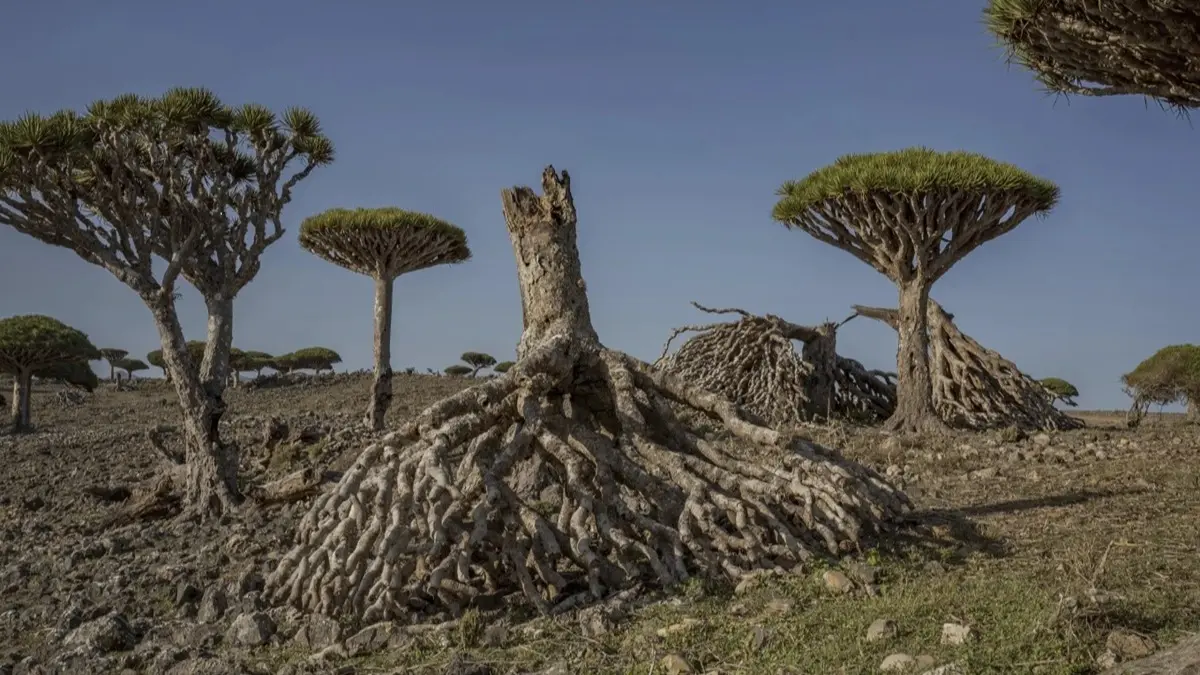Updated 19 May 2025 at 15:53 IST
UNESCO World Heritage Site: Socotra Archipelago's Ecosystem In Danger - See Why Dragon's Blood Tree Has To Be Preserved
Dragon's Blood Tree, exclusively found in Socotra Archipelago, Yemen, is an endangered species increasingly in danger due to climate change and invasive species.
- World News
- 4 min read

Yemen: The dragon’s blood tree, a rare sapling exclusively found on the Socotra Archipelago, a group of Islands in the Arabian Sea located around 210-380 miles off the coast of Yemen, is an ankle-length, young vegetation protected by an ensemble of wood and wire on the bleak, windy island of Socotra.
One of the oldest surviving endangered forest communities on Earth, once found in great numbers, is now collapsing due to climate change, overgrazing, and other human activities.
Dragon’s Blood Curing People:
Standing tall with its mushroom-shaped canopies, the trees produce a bright resin popularly known as the dragon’s blood, which has been used in traditional medicine for various ailments, including skin diseases, pain relief, and gastrointestinal issues.
Studies even show dragon's blood resin having antidiarrheal, antimicrobial, antiviral, antitumor, anti-inflammatory, wound-healing, and antioxidant properties. Along with these uses, it is also a tourist attraction with its red ornamental appearance, and is used in religious rituals too.
Advertisement
Not Just Dragon’s Blood, Socotra Cradles 800+ Plant Species:
Floating in peaceful isolation, Socotra houses many biological riches, including 825 plant species, one-third of which are exclusive to Socotra, earning it a United Nations Educational, Scientific and Cultural Organization (UNESCO) World Heritage status.
Still, among all these, Dragon’s blood trees draw around 5000 tourists annually to their ethereal beauty. Tourists are required to hire local guides and stay in campsites regulated by Socotran families, which ensures local distribution of all monetary gains.
Advertisement
What Threatens The Dragon’s Blood?
These unique, otherworldly trees have survived varied, rugged atmospheres so far, from being victims to severe cyclones and grazing by invasive goats to persistent turmoil in Yemen, one of the poorest countries in the world with more than a decade-long civil war, but now have been pushed to the edge as the torture intensifies.
Cyclones Uproot Socotra’s Ecosystem:
The Arabian Sea has seen a rise in severe cyclones across the island that tear the trees down. In 2015, a devastating cyclone uprooted over 500-year-old trees, followed by a 2018 cyclone causing larger destruction than the previous ones. As the greenhouse gas emissions rise, so will the intensity of the cyclones and storms in the region.
Grazing is a threat to the tree’s survival:
Jagged Mountains is a haven for the largest remaining Dragon’s Blood Forest, where Egyptian vultures rest in between restless hunting sessions, and goats walk through the rocky terrain to feed themselves.
But goats can be a danger to the species, as the tree just grows about 1 inch annually, and by the time it is supposed to reach maturity, it succumbs to grazing by invasive goats.
This necessitates the protection of the trees in fences to stop the goats from devouring the vegetation. Though some Socotran families have built enclosures for the trees to thrive, studies show the forests that already exist are old, and there is no sign of regeneration. So the old ones die, but there are no new seedlings.
Conflict Complicating Unity On Protection Of Trees:
Amid the battle between the Saudi-led internationally recognized government and Houthi rebels backed by Iran, Yemen has to prioritize essential services like electricity and water, and simply cannot unite on the protection of vegetation at the moment when most of its people are dying due to food insecurity.
The ongoing civil war has displaced millions. It's a humanitarian crisis in Yemen with water scarcity due to drought, groundwater depletion, and infrastructure destruction caused by the conflict, adding on to the dire situation.
Lose The Trees, Lose Everything:
Dragon’s blood trees are not just trees, it shoulder the responsibility of the survival of neighboring plants. With their umbrella-like canopies, the trees absorb fog and rain to channel it into the soil, allowing the other plants to thrive in the arid landscape.
The dragon’s blood tree supports the entire ecosystem of the Island. If the trees cease to exist, many islanders who survive on the tourism industry might also vanish into thin air. Scientists have regularly warned about the disappearance of the trees within a few centuries due to human ignorance. To combat this, locals’ efforts alone are not enough due to limited resources. Yemeni government’s support is essential to prioritize conservation.
Published By : Isha Bhandari
Published On: 19 May 2025 at 15:53 IST
